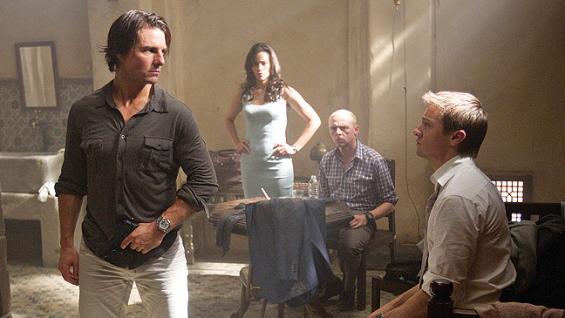
Brad Bird loves James Bond. This was evident in the Sean Connery-era 007 touches he infused into his Pixar hit The Incredibles. It is even more evident in the director’s recent Mission: Impossible episode (gone is the numerical increment, instead we’re given an honest-to-god subtitle, Ghost Protocol), an enjoyably absurd spectacle that hearkens back to the legendary British spy’s Roger Moore period of high-tech gadgets, gizmos and gimmicks.
A tongue-in-cheek prison break set to a Dean Martin classic establishes the tone, and the opening credits are themselves a rousing reworking of the 1996 Brian De Palma series launch. It’s a giddy start that promises much and nearly delivers it, and is almost as nearly undone by the lack of innovation in the screenwriting.
Certainly the performances are inferior to the previous three, more wooden than even the deliciously cornball theatrics of part two. They feel almost like rehearsals, as if Bird is fully aware that the stunts and set pieces will be entrusted with the more critical dramatics of the movie. Yet there is a relaxed air that goes far in giving the proceedings room to breathe, everyone cognizant of the absurdities in which they are partaking and deciding this time to just have fun with it. That sense of merriment is certainly an improvement over the previous dire and dull J.J. Abrams entry.
Unfortunately, the film has a crushingly heavy reliance on techno-toys. There’s no challenge facing this team for which they are not supplied a handy technological solution, conveniently tucked away in a shoulder bag. There isn’t even so much as a pre-game supply check before whatever device, custom-made for the immediate job at hand, materializes out of thin air (a pair of gloves that can adhere to any surface apparently have the additional magical property of keeping one’s hands from slipping out of them). Even the most farcical Bond movies didn’t rely on this many convenient contraptions. To Bird’s credit, he does at least demonstrate that this technology fails the team as often as not. Even the famous five-second self-destruct needs a little extra priming, a little extra punch.
Fortunately, Bird and company don’t let you stop to think about such things, moving briskly from one inventive action sequence to the next. The much ballyhooed Burj Khalifa Tower acrobatics are truly dizzying and one must be impressed by star Tom Cruise’s adrenaline-addicted willingness to do his own insane stunts. The obligatory car chase, though aided by some CGI, nevertheless introduces a unique twist into a stock contrivance courtesy of Mother Nature. The climax is mired in some wincing implausibility (the US has apparently lost all ability to track unexpected inbound air traffic), yet it needn’t detract from the clever use of an automobile carousel for the final showdown.
Robert Elswit’s cinematography is a refreshing return from the spasmodic jitters of the previous film. Richly golden sand dunes and the Khalifa’s strikingly silver windows recall the glory of 70mm, the towering IMAX screen providing a much more immersive experience than 3D. Elswit and Bird have enough respect for the audience to let film editor Paul Hirsch cut the urgency and emotion into (or out of) a scene, rather than rattle you with tremors. It’s nice to see a director who knows how to use each tool in his arsenal when the trend today is to rely only on one.
Goes great with: Die Hard (1988). The sacred cow of modern action pictures. Ghost Protocol‘s centerpiece is the perfect accompaniment to John McTiernan’s classic genre-maker.
Disagree? That’s fine by me. Share your thoughts below.

You must be logged in to post a comment.